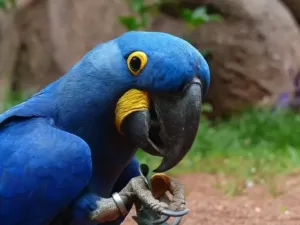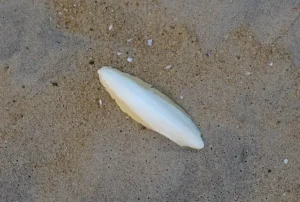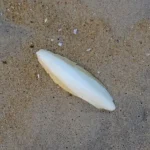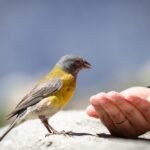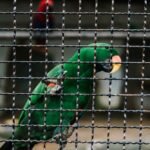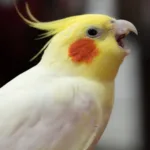If you’ve observed your parrot closely, you may have noticed that they tend to use one foot more than the other. Whether, it is for grasping food, playing with toys, or making a safe landing even. “Handedness” is a common trait in all vertebrates. The human population is predominantly right-handed. But that isn’t the case with the parrots.
Most parrots have a preferred foot with which they perform their daily activities. This preference is usually developed over time as a parrot grows into an adult. Studies show, that a majority of parrots show a preference for using their left foot.
There have been numerous studies on the footedness of parrots and the results have been fairly consistent. A very low population of parrots is right-footed and fewer are ambidextrous.
Quick Navigation
Are Parrots Left Or Right-Footed?
Parrots can be both left and right-handed, but a vast majority of them show a preference for the left foot.
In a study published in Biology Letters, researchers looked at 16 different species of Australian parrots to understand their foot preference.
Around 47 percent of the parrots in the study were left-handed, and only 33 percent were right-handed. The remaining were ambidextrous.
In addition to that, they also observed which eye the parrots preferred to use when they were looking at something. This is because a parrot’s vision and their ability to interact with what they see often go hand in hand.
Since parrots have to tilt their heads to see what’s in front of them, a preference for one side of their body determines which way they turn.
It turns out that the eye the parrot used to look at things strongly influenced which foot it used to do different tasks.
Across all the different parrot species studied, the preference for using a particular eye explained about 99 percent of the reason why they used one foot more than the other.
This means that there’s a strong connection between what parrots see with their eyes and how they use their feet to interact with their environment. This pattern was consistent in most of the parrot species they studied.
The eye and foot preferences of these parrots are closely linked, and what they see with their eyes tends to determine which foot they use.
Another study by Taylor & Francis tried to understand foot preference in ring-necked parakeets. A population of parakeets was observed in Heidelberg, Germany, where they were feeding on catalpa trees that had 20- to 50-cm-long fruits.
The parakeets eating the catalpa fruits used one foot to hold the fruit while biting it with their beaks. Some parakeets used their left foot for this, while others used their right foot.
To further investigate this, the researchers set up an experimental site where they provided appropriately sized pieces of apple that required the parakeets to use only one foot to handle the food.
Out of 184 parakeets observed on the catalpa trees, 102 of them used their left foot, and 82 used their right foot.
In the experiment feeding location, 24 parakeets showed a preference for their left foot, while 11 preferred their right foot.
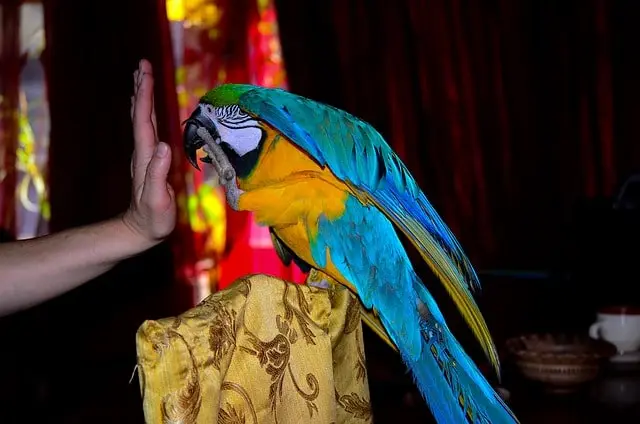
Is Footedness Advantageous To Parrots?
Footedness, like handedness in humans, is related to differences between the right and left hemispheres of the brain. The left hemisphere controls the movement on the right side of the body, and similarly, the right hemisphere governs the left side of the body.
In humans, ambidextrous people tend to perform well when it comes to physical handling. But is that true for parrots as well?
According to a study published by the Proceedings of the Royal Society B, parrots with a dominant foot are better at problem-solving and foraging compared to parrots that are ambidextrous.
The study aimed to understand if cerebral lateralization, provides any advantages in problem-solving for Australian parrots.
They conducted two different tests to see if parrots with strong lateralization (those who strongly favored using one side of their body) performed better in these tasks compared to parrots who did not.
The first test involved a pebble-seed discrimination task, which was for smaller parrot species that mainly eat small seeds. This task didn’t require much foot manipulation before eating.
The second test was a string-pull problem, meant for larger parrot species that often use their feet to handle food objects.
In both tests, parrots that were either left or right-footed performed better than parrots who were ambidextrous. This difference was even more noticeable in the more challenging task, the string-pull problem.
These results suggest that cerebral lateralization is a common trait among Australian parrots, and it provides a significant advantage when it comes to foraging and problem-solving.
Does Footedness Affect How Parrots Perch?
You may have noticed that your parrot tends to use one foot to step down or step up on their perch. When you ask for a step up, the foot it holds forward is usually the dominant one.
According to a study by eLife, parrots use their dominant foot not only for manipulating objects but also for perching. When approaching a perch, parrots would open their feet, and the dominant foot would typically make contact first.
Researchers also observed that the parrots made adjustments to their foot positioning after landing, depending on the surface. Parrots made the most adjustments on Teflon perches and the fewer on 0.25″ diameter birch dowel.
